Last Updated on: 12th August 2021, 07:50 pm
With the recent discovery of nearby Göbekli Tepe, the city of Şanlıurfa has been placed firmly on Turkey’s tourism map. But Urfa, as most people call it, is an essential destination in its own right. In addition to being the possible birthplace of Abraham, Urfa is also home to significant Roman tombs and mosaics. And the new Şanlıurfa Museum, which focuses on the province’s many Neolithic settlements, is arguably the country’s finest. In this Urfa guide, we’ll be covering it all.
The city was only named Şanlıurfa (‘Glorious Urfa’) in the 20th century, but most people still call it by its former and simpler name, Urfa. It was also formerly known as Edessa, a name chosen by Alexander the Great.
As the birthplace of civilization, Urfa’s full history is incredibly long and complex. All of the locations mentioned below focus on a different aspect of the city’s history, and we’ll be getting into more detail as the Urfa guide progresses.
Most people stay several nights in the city, using it as a base for day trips to Göbekli Tepe and Harran. Within the city center, one full day is enough to see all the sites mentioned below on foot.
It would be a good idea to tour the city center on your first day, as the Şanlıurfa Museum provides excellent information on the other important sites throughout the region.

Balıklıgöl (Fish Lake) & Urfa Castle

Abraham, born sometime in the 20th century BC, is regarded in Judaism, Christianity and Islam as the forefather of the prophets. Accordingly, these religions are often referred to collectively as the Abrahamic faiths.
In both the Bible and the Quran, Abraham’s birthplace is named Ur of the Chaldees. Most Western scholars are firm in their belief that this is the southern Mesopotamian city of Ur, located in modern-day Iraq.
But another promising candidate is the city of Urfa in northern Mesopotamia. Notably, the holy books also say that Abraham stayed in Harran for a time, and there’s virtually no disagreement that this was indeed the Harran located in Şanlıurfa Province.
With that in mind, Urfa, only 44 kilometers from Harran, is likely to have been the real Ur of the Chaldees. And locals certainly think so, as numerous landmarks within central Urfa have been identified with parts of Abraham’s story.
To see them, first head over to Balıklıgöl, or the Fish Lake.


Entering the area, you’ll find elegant mosques built around a rectangular pool full of carp. But where do carp appear in Abraham’s story?
According to Islamic tradition, Abraham’s father was an idol sculptor. And Abraham was even tasked with selling these idols in the marketplace during his youth. But Abraham mocked the idols and the people who bought them, as they could not move or speak.
Later on, he even vandalized the idols in the local temple, blaming it on one large idol which he left standing. The king, whose name was Nimrod (Nemrut in Turkish), interrogated Abraham, arguing that a stone idol couldn’t have done such a thing.
Abraham then asked the king why he prayed to something that couldn’t move. Nimrod, infuriated by Abraham’s attitude and disrespect for the local traditions, condemned Abraham to death.

According to the story, local townsfolk gathered enough wood to create the biggest bonfire anyone had ever seen. And Abraham was catapulted from atop a nearby hill (Urfa Castle) as Nimrod looked on.
But as Abraham was falling into the fire, the Angel Gabriel came to him and asked if he could help. Abraham replied that whatever happened to him was the will of God/Allah. Allah, impressed by his answer, made it so that the fire was transformed into a lake upon Abraham’s landing.
The embers of the fire, meanwhile, were transformed into the fish we see today. And despite the modern park being home to several restaurants, the carp are definitely not on the menu, as they’re believed to be holy.



The tranquil complex is also home to a tomb of a 20th-century Sufi saint. You can also step into the Halil Ul-Rahman Mosque, built over a former church, to see a room quite unlike any other.
Just outside the main prayer hall is a small room with a transparent glass floor through which visitors can observe the sacred fish. Just above the pond is a tap which many visitors drink out of, but it’s not quite what it seems.
Taking a sip, I was relieved that the water didn’t taste the least bit fishy, but I’m still not sure of its source.

Nearby is yet another pool, this one named after Zeliha, Nimrod’s daughter.
According to the Quran, Zeliha defied her father and became a follower of Abraham and his deity. As punishment, Nimrod even had her catapulted into the fire as well! And luckily for her, it was also transformed into a pool of water.
The Pool of Zeliha is now entirely surrounded by fancy restaurants, and guests can even rent small boats to ride around on.


Balıklıgöl, along with the park area which surrounds it, is situated at the base of a large mound. And on top of the hill is Urfa Castle, the place from which King Nimrod supposedly watched Abraham fall into the fire. At the time, it may have also been a temple to the Semitic god Baal.
Like many things around here, however, the castle is even much older than Abraham’s era.


Humans have inhabited this site since at least 10,000 BC, around the time Göbekli Tepe was established. The castle was in continuous use for thousands of years, and the two Corinthian columns at the top date to the 3rd century AD.
They’re attributed to a king named Manu IX. According to a nearby inscription in the Syriac language, they were erected by a military commander’s son in honor of the royal family.


Unfortunately, the castle has been closed to visitors for years due to archaeological excavations. You can, at least, walk all the way around it and get a clear view of the trench surrounding the fortress.
The structure we see today largely dates back to the 9th century AD during the Abassid period. Interestingly, an underground tunnel supposedly connects the castle with the nearby Pool of Zeliha.


Also at the base of Urfa Castle, just a few hundred meters southwest of Balıklıgöl, is a mosque called Mevlid-i Halilulrahman Mağarası. And within it is a cave believed to be Abraham’s birthplace.

Before his birth, it was prophesied that a child would be born who’d threaten Nimrod’s reign. As a result, the king decreed that all newborn babies born in that year be put to death.
As a result, Abraham’s mother secretly gave birth in a cave. And locals believe it to be this one, which, oddly enough, just happens to be a stone’s throw away from the royal castle.


Today, anyone can enter the cave area within the mosque for a look. It’s largely filled up with water and can only be viewed from the other side of a glass barrier. But it certainly makes for an interesting visit regardless of your faith (or lack thereof).
The mosque around it, meanwhile, was built in the 16th century during the Ottoman era. There was originally a pagan temple at the spot, and later a Jewish synagogue followed by a Christian church.
Şanlıurfa Museum
Şanlıurfa Province is home to the world’s very oldest temples and settlements, while Urfa has remained an important city ever since.
Such a significant place requires a truly special museum to do it justice. And thankfully, the Şanlıurfa Museum, opened in 2015, is a resounding success. In fact, it’s arguably the best archaeology museum in the country, and even among the top in the world.
The museum takes visitors through every era from prehistoric up until Islamic times. But there’s a special focus on the Neolithic era. After all, most visitors coming to Urfa are doing so to visit Göbekli Tepe. And this museum is one of the best places to learn about it before your visit.
After an overview of the Paleolithic era, you’ll enter the Neolithic section and come face to face with one of the most significant artifacts on the planet.
- Çamlık Cad
- 8:00 - 17:00
- Closed Mon.
- 18 (as of 2020)



The statue, nicknamed ‘Urfa Man,’ was discovered just north of Balıklıgöl in the 1980s. Amazingly, at around 12,000 years old, it’s the oldest life-size statue (1.8 meters) ever found! (Thankfully, Abraham never got to it.)
Urfa Man was carved of limestone but has black obsidian eyes. He’s bald with a prominent nose and no mouth. Interestingly, his V-shaped necklace resembles some of the patterns carved on the pillars of Göbekli Tepe, and he was likely created by the same culture.
And speaking of Göbekli Tepe, the next room focuses on a wide variety of artifacts discovered there, from tools to religious art. Taking your time here is a must before you visit the actual site.

For those unaware, Göbekli Tepe is one of the world’s oldest temples, dating back to at least 12,000 years ago. The skills and organization required by a society to erect such huge megalithic pillars are beyond what academics ever thought humans from this era were capable of.
The site was not seriously studied until the 1990s, and it’s since changed everything we thought we knew about human history. It also challenges the notion that agriculture came first, followed by the creation of elaborate religious structures. Göbekli Tepe and similar sites reveal that the reverse was likely the case.
We’ll be covering the amazing collection of animal statues and other carvings on display at the museum in our dedicated Göbekli Tepe guide.

Aside from authentic original pieces, the Şanlıurfa Museum also has a scale model of Göbekli Tepe’s largest and most interesting section – Enclosure D.
Currently, visitors to Göbekli Tepe can only see it from above. Therefore, getting an idea of what it’s like to walk around within the enclosure is a special experience that can only be had here.
But Göbekli Tepe isn’t the only Neolithic site with a scale model at the museum.

Like Göbekli Tepe, Nevalı Çori was also a Pre-Pottery Neolithic site, located in the north of Şanlıurfa Province. It’s younger by a couple thousand years, however, dating back to sometime between 8,500-8,000 BC. The site contained both settlements along with a temple.
As opposed to Göbekli Tepe’s circular enclosures, Nevalı Çori’s temple was rectangular. The temple, however, utilized the very familiar-looking T-shaped pillars of Göbekli Tepe, and they even have the same human arms which twist around the side.
Infuriatingly, Nevalı Çori was completely destroyed by the Ataturk Dam in 1992. Though the site is now lost forever, many of its items were salvaged, and the pillars on display here are originals.
One remarkable feature of Nevalı Çori’s temple is something most of us wouldn’t notice – the flatness of the floor. To get such an even surface, the builders had to go through a long process of creating a plaster mix from burnt limestone and water. This reveals a higher technological sophistication than previously thought possible for the era.



Also salvaged from Nevalı Çori were many of its statues and stone vessels. Of special note is the large head of a statue with a snake slithering up the back of the skull. Those familiar with the traditions of the Indian Subcontinent will likely notice the symbolic parallels.



Other Neolithic sites presented at the museum include Arkaçay Tepe, at which builders constructed sturdy stone houses. It dates back to around the same time as Nevalı Çori.
There are also numerous impressive stone vessels on display. As far as we know, the firing of clay to make regular pottery didn’t happen until around the 7th millennium BC. But it’s amazing to see what the Pre Pottery Neolithic cultures were capable of making with hard stone.



Eventually, the museum takes visitors through the Chalcolithic Age (5500-3300 BC) and the Bronze Age (3300-1100 BC). (Only now have we reached the era in which Abraham lived!)
It was during this era that the Akkadian, Assyrian and Mittani kingdoms flourished throughout Mesopotamia.
As mentioned above, the Şanlıurfa Museum’s main focus is on the Neolithic Era, but there are some interesting Bronze Age items on display as well. Look out for the small figurines and the terracotta toy cars – the ancient precursor to Hot Wheels.


Next comes the Iron Age (1100-330 BC), a period that saw civilizations like the Hittites, Phrygians and Urartians flourish in Anatolia.
The main highlight of this room is the collection of stelae from Harran which relate to the local tradition of moon worship. But more on those in our dedicated Harran guide.

Finally, visitors arrive at the Greco-Roman section of the museum. While nowadays, we commonly think of this era as being ancient, it’s actually quite recent when looked at within the entire span of human civilization. And a walk through this museum really puts that into perspective.
The next two locations in this Urfa guide, situated just nearby the Şanlıurfa Museum, are original sites which date back to Roman times and should not be missed.
Haleplibahçe Mosaic Museum

Just a few hundred meters south of the Şanlıurfa Museum is the Haleplibahçe Mosaic Museum, entry to which is included in your museum ticket.
This is more than just a building where a bunch of mosaics are presented, like at Gaziantep’s Zeugma Mosaic Museum. The art on display here remains in its original location!
The mosaics were only discovered as recently as 2006, when workers were installing a new sewer pipeline. Fortunately, rather than try to move to beautiful mosaics elsewhere, local officials decided to build a dome over the original spot.
The elaborate villa, belonging to a Byzantine official, featured 12 rooms. And its mosaics are revered for both their subject matter and high quality.

Among the notable scenes displayed on the flooring is that of the Sea Goddess, Thetis. We see her dipping her son, Achilles, into the River Styx, one of six rivers which flowed through Hades.
In doing so, she intended to make her son immortal. But as demonstrated in the mosaic, she never let go of her son’s right ankle, leaving this part of his body vulnerable.
Elsewhere, we see the Achilles as a grown man. Achilles, of course, would go on to become a hero of the legendary Trojan War.


But he would ultimately die upon being shot in his right heel by Paris, the man whose elopement with Helen triggered the war in the first place.
If you’re at all interested in the mythology surrounding the Trojan War, be sure to visit the actual site of Troy.
It’s all the way on the opposite end of the country, nearby the city of Çanakkale. The new Troy Museum there provides great background info on the various scenes and characters, along with historical finds from the site.
Walking along, you’ll encounter a scene of the centaur (half-man half-horse) Kheiron. Kheiron overcame his primal, beastly nature to become a skilled botanist and an expert at many other topics.
He would then mentor young heroes throughout Greek mythology, including Achilles. In the mosaic, we can see what appears to be Kheiron teaching Achilles new combat techniques.
Elsewhere, another well-preserved mosaic is that of Ktisis, a goddess who founded cities and also stuck around to protect them. In the Greco-Roman world, she was also a symbol of fortune and good luck.




One of the most remarkable mosaics of the villa is not mythological. It simply depicts a servant with a zebra. Zebras, of course, are not native to this region and would’ve had to be imported from somewhere in distant Africa.
The servant appears to have come from Africa as well. But the stones used to create the mosaic, on the other hand, were taken from the nearby riverbed of the Euphrates.



Arguably the most significant section of the mosaic flooring is the part which features the Amazons. The Amazons were a group of female warriors and huntresses who were native to Scythia in Central and West Asia.
They were notorious for having one of their breasts removed so that they could better pull back a bow. And within one massive scene at the villa, we can see four Amazon warriors taking on all sorts of exotic animals.
The scenes are so impressive, in fact, that this whole location has been nicknamed ‘Villa of the Amazons.’

All of the mosaics above have been left in place exactly where they were first created. But elsewhere around the Haleplibahçe Mosaic Museum are scenes taken here from elsewhere around the region.
Among the most noteworthy is the Orpheus Mosaic. It’s originally from Urfa but was long kept in the Dallas Museum after being smuggled abroad. And upon its return to Turkey, it was kept in the Istanbul Archaeology Museum for awhile before finally returning home.
In the scene we see Orpheus, the mythological poet and musician, playing his lyre while surrounded by various animals. It was once part of a tomb from the 2nd century AD, and its writing in the Syriac language names the artist, a person named Ber Saged.
Kızılkoyun Necropolis
During your walk from the Şanlıurfa Museum to the Haleplibahçe Mosaic Museum, you’ll have noticed a series of holes cut out in the natural rock on the other side of the highway. For whatever reason, it’s seldom mentioned in guides.
But the area is indeed an ancient necropolis. And it’s also accessible for visitors free of charge.
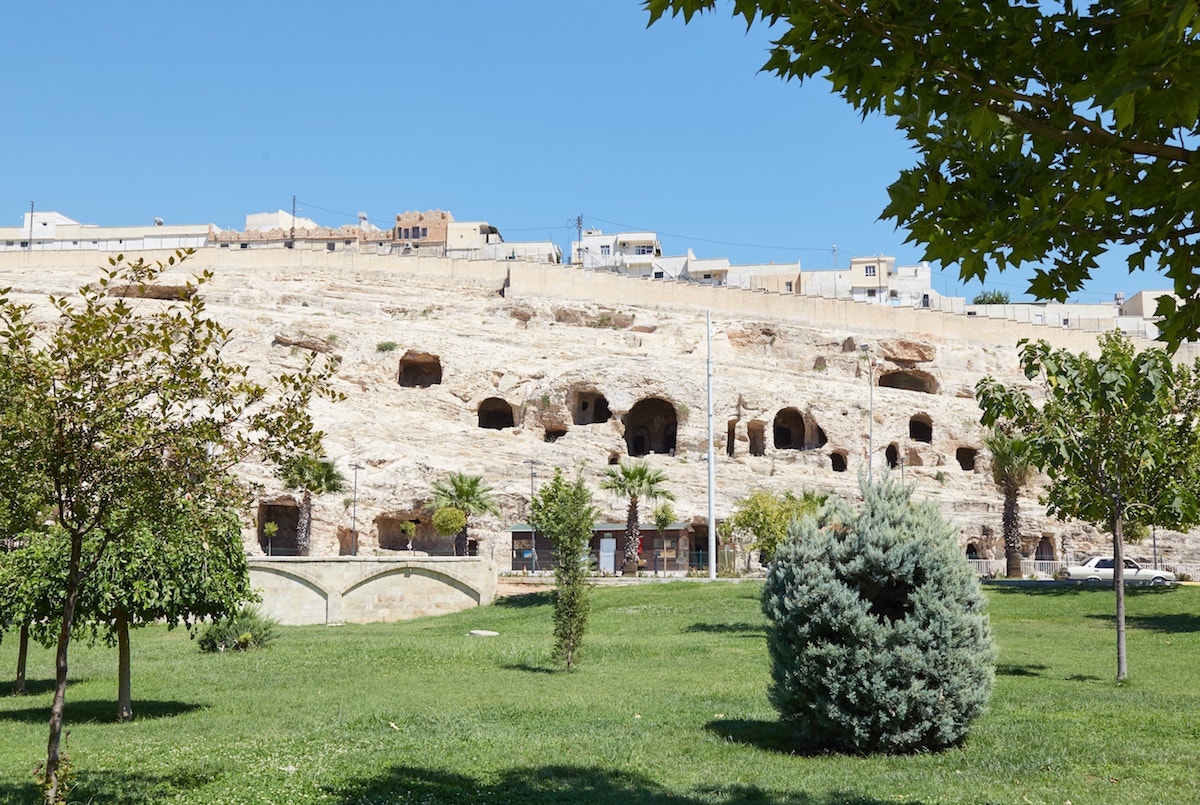
Kızılkoyun Necropolis is a Roman-era cemetery dating from the 2nd-4th centuries AD – a few hundred years before the Amazon Villa just across from it. Rome first solidified its hold over Anatolia by the 2nd Century BC, taking over the territory once held by the Hellenistic Seleucid Empire.
They then set their eyes on southeast Anatolia and Mesopotamia, as it bordered their main rivals, the Persian Parthian Empire. But it wasn’t until the 2nd century AD that Emperor Caracalla finally took Edessa (Urfa).
And it’s from around that time that this necropolis was first put to use.

There are 61 rock tombs in total, many of which can be entered. The tombs were usually carved to be rectangular, with space for the sarcophagus and for offerings to be left by relatives of the deceased.
Some of them were also carved with reliefs of mythological scenes, though they’re hardly discernible today.
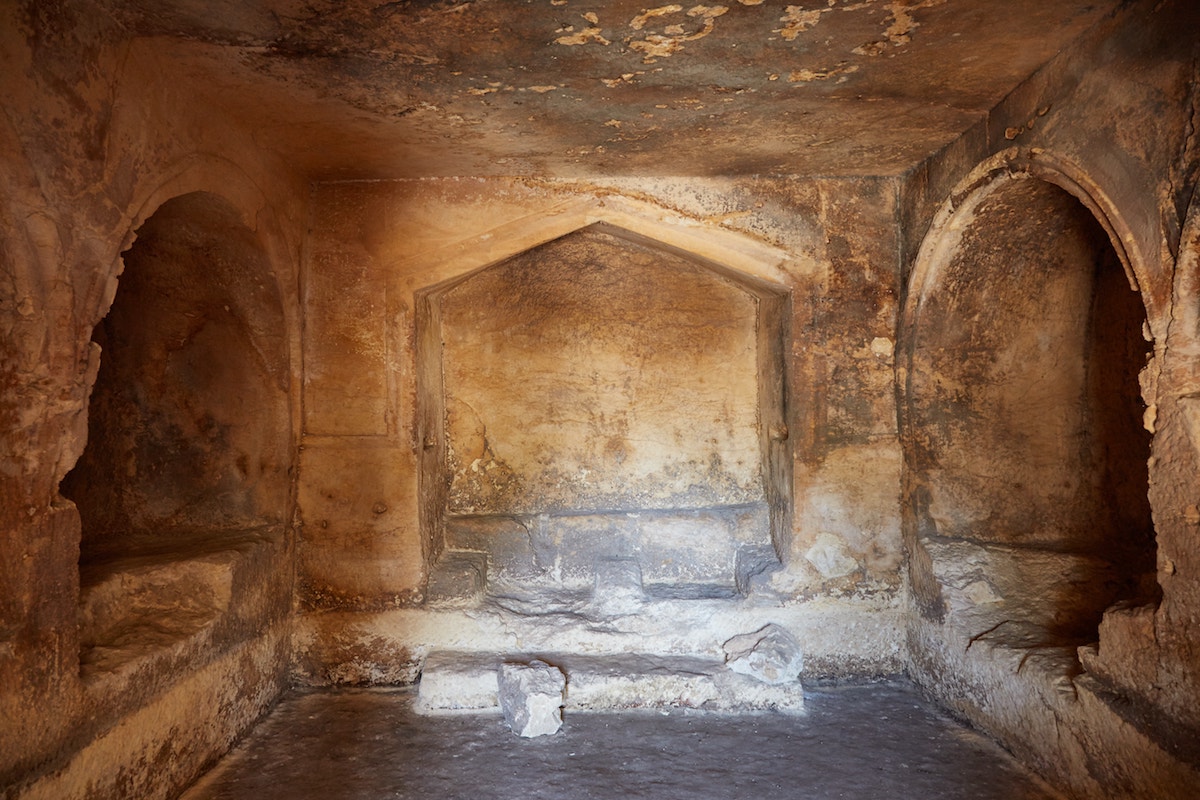


As you head further south, the tombs become larger and more elaborate. Some of the tombs even have props placed inside, such as figurines and skeletons, to help visitors get a feel for how things once appeared.
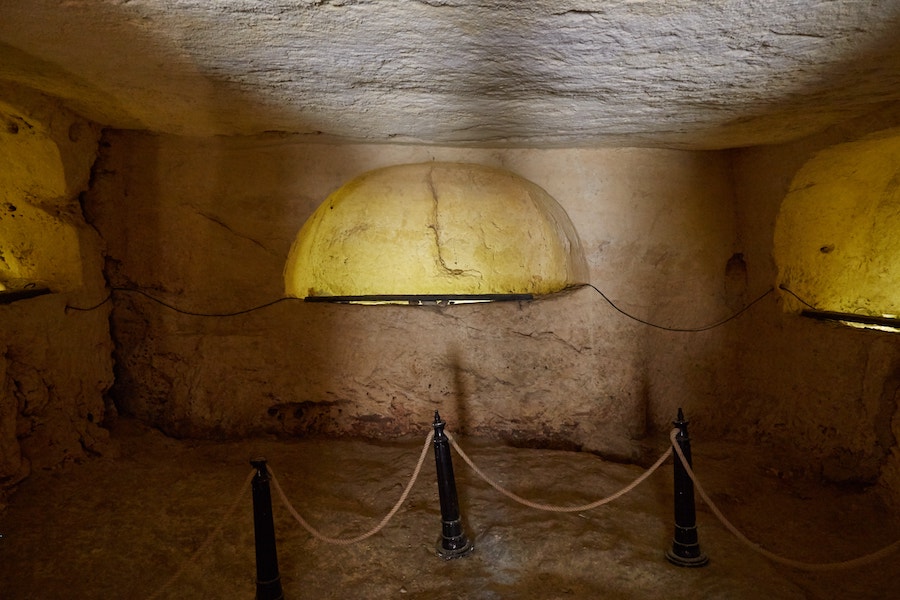

Some of the tombs even have elaborate columns and gateways in front of their entrance. It’s unclear whether these are originals or recreations, but presumably, most tombs appeared this way from the outside centuries ago.
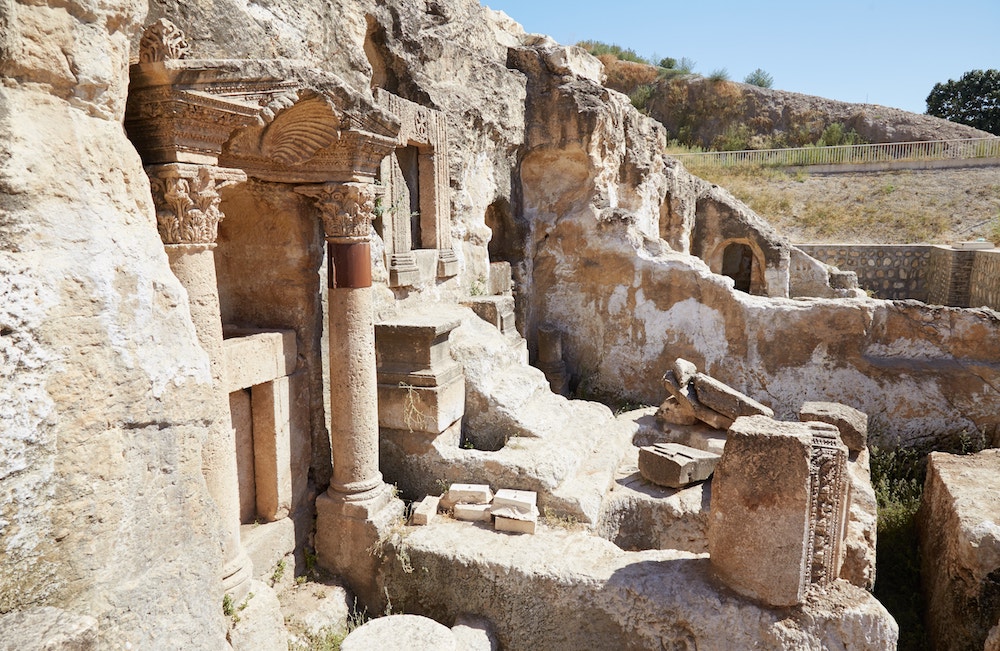
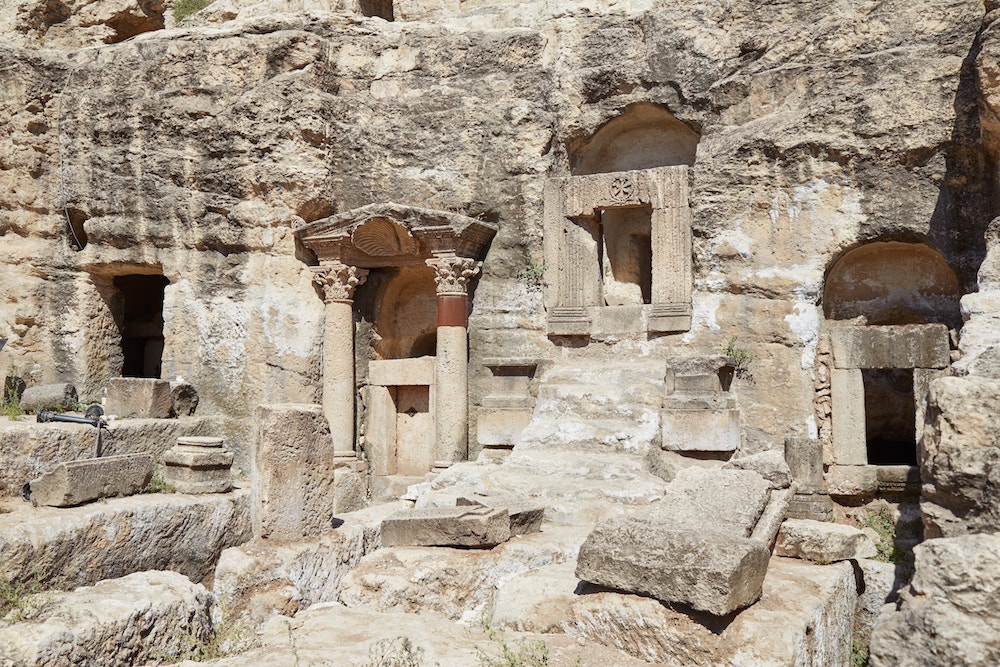
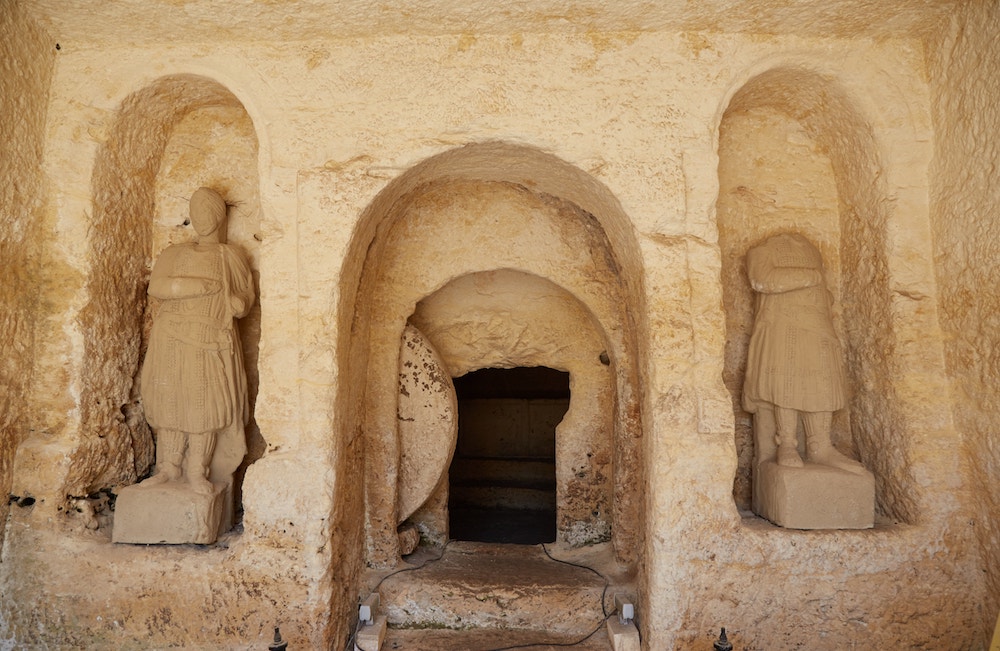

One of the larger tombs has niches for two statues to be placed out front. The ones there now are recreations, though the original can be found in the Şanlıurfa Museum.
Also note the circular monolith in front of the entrance. These contraptions were also used to block openings in Cappadocian underground cities like Derinkuyu.
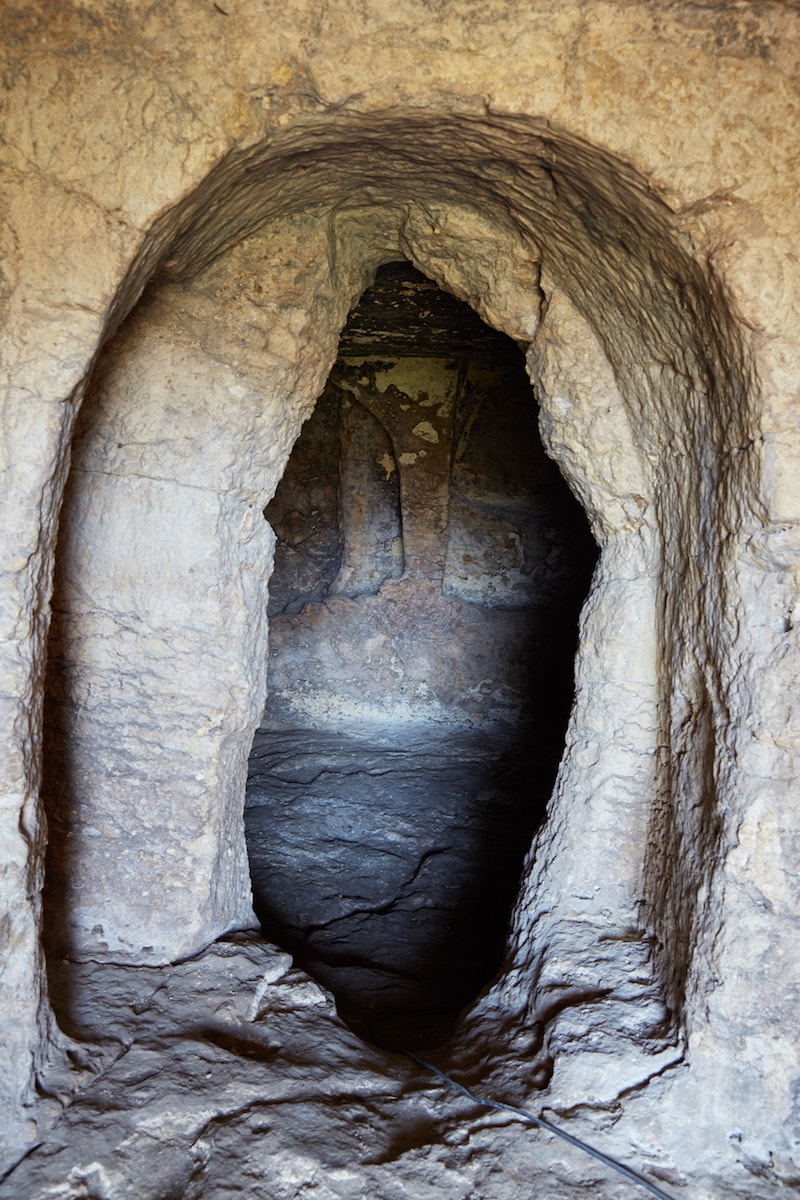
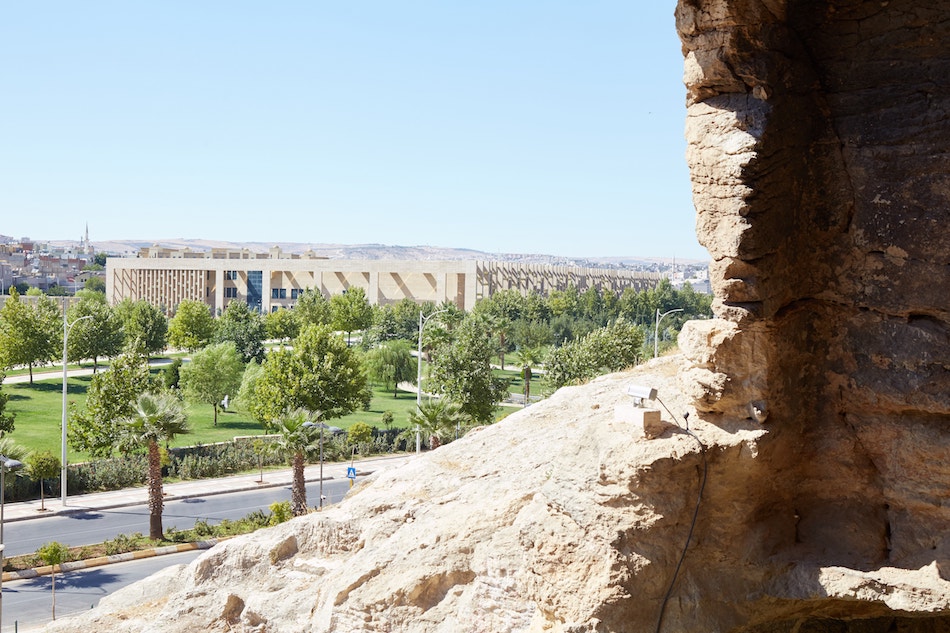
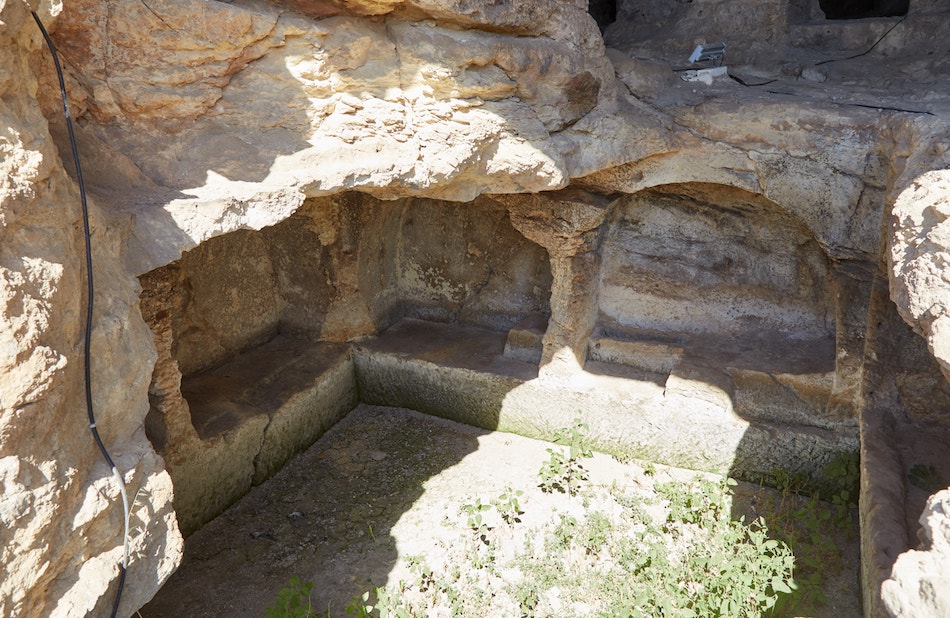

Across from the necropolis, meanwhile, are the ruins of an old Roman bath.
Admittedly, having come straight from beautiful Mardin, Urfa didn’t leave the greatest first impression on me.
It’s a crowded, hot and dusty city. But the more you walk around, the more random discoveries you’ll make.
And after so many pleasant surprises like these, the city really grew on me over time – a feeling further enhanced by the friendliness of the locals.
More Around Urfa
For those with extra time, there are a few additional sites to check out around Urfa. In the city center is the Ulu Cami, or the Grand Mosque, known for its tall octagonal minaret.
Built in the 12th century, it was modeled after the Grand Mosque of Damascus, Syria, much like the Ulu Cami of neighboring Diyarbakır.

Also within central Urfa is the Klaus Schmidt House, the residence of Göbekli Tepe’s head archaeologist. Sadly, Schmidt passed away in 2014, but his wife still resides in Urfa and operates the house-turned-museum.
There are no official opening hours, and there’s a good chance you’ll arrive to find it locked as I did.
Regarding archaeological sites, 5 km south of the city center is Deyr Yakup Manastırı, alternatively known as Nimrod’s Throne.
Locals say that this was the spot of Nimrod’s palace away from the city, though the current remains are much more recent.
The site contains a 1st century BC mausoleum belonging to a prince of Edessa. And centuries later, as the name suggests, it was used as a monastery.
If you’re a fan of Turkish cuisine, Urfa (along with nearby Antep) is one of the country’s most famous cities for food. In addition to normal cooked kebabs, Urfa is also known for its çiğ köfte, or raw kebabs!

Additional Info
Central Urfa isn’t a huge area. If you’re within walking distance to the Şanlıurfa Museum or Balıklıgöl, you can easily visit everything mentioned in the Urfa guide above on foot.
However, if you want to visit both Göbekli Tepe and Harran by bus, you should consider your location more carefully. The bus stops for both are around 3 km north of the city center.
I decided to look for something in between the two locations (that was also within my budget) and found the Emir Sultan Hotel.
For less than $10 a night, I had a private bathroom, decent wifi and free breakfast. The biggest downside was the lack of AC – kind of unthinkable in Turkey’s hottest city at the hottest time of year. The fan they provide, at least, was very strong. And the staff were helpful and kind.
If you’re not on such a strict budget but are still interested in taking a bus to Göbekli Tepe and Harran, I’d still recommend the general area around Emir Sultan. (Hotel Guven looks like a good option.)
It’s also by the restaurant Sumer Lahmacun, one of the best lahmacun places I visited in Turkey.
Şanlıurfa has its own airport about 15 km south of the city. It connects with major cities like Istanbul, Izmir and Ankara.
There is no rail access, so most people arrive by car or bus.
The main otogar (bus terminal) is several kilometers north of the city center. Apparently, two buses are required to get to the city center, so just taking a taxi is the best idea. As of 2020, the ride should cost 25 lira or so.
(Going to the otogar isn’t required to visit Göbekli Tepe and Harran. See the bus stop locations in the map above.)
Şanlıurfa is one of southeast Turkey’s biggest cities, so in theory, there should be many direct connections with other cities in the region. But I had strange experiences both coming to and departing from Urfa.
Despite having bought a direct ticket from Mardin to Urfa, I was made to transfer to a minibus without warning midway through the ride (avoid the company Dilmenler Mardin at all costs! See my horror story at the end of this guide).
When done with Urfa, I went on to see Mt. Nemrut, the nearest town to which is called Kahta. And despite having bought a ticket which simply said ‘Kahta’ and getting no additional info from the ticket seller, I was made to transfer at Adiyaman. (It was at least much smoother than the Mardin ordeal.)
Strangely, in three months of traveling around Turkey by bus, my journeys to and from Urfa were the only times I was suddenly transferred from a coach bus to a minibus mid-ride.
While the Turkish government isn’t quite as extreme as China when it comes to online censorship, you’ll probably want a decent VPN before your visit.
I’ve tried out a couple of different companies and have found ExpressVPN to be the most reliable.
Booking.com is currently banned in the country (at least when you search for domestic accommodation). However, there are actually quite a few Turkish hotels listed on there anyway. And many them don’t even appear on Hotels.com, which hasn’t been banned.
Over the course of my trip, I ended up making quite a few reservations with Booking.com and was really glad I had a VPN to do so.
Another major site that’s banned is PayPal. If you want to access your account at all during your travels, a VPN is a must.
While those are the only two major sites that I noticed were banned during my trip, Turkey has even gone as far as banning Wikipedia and Twitter in the past.

Hi from Rio, Brazil. All of Upper Mesopotamia is absolutely MAGICAL, but Urfa province is something else, it’s in a league of its own. This region is the “Zero Point in History” on Earth, of the one proto-civilization , connected to most Prophets and Patriarchs; Harran Plain and Taş Tepeler area were the most likely inspiration for the GARDEN OF EDEN, Paradise Lost by climate change / meteor impact 12,000 years ago !
Urfa province needs its own history-based geographical denomination, similar to broader “Fertile Crescent” or “Mesopotamia”. I suggest it should be specifically called “TERRA HISTORICA”. What do you think?
On the slopes of the hill under Urfa Castle, there are some chambers with amazing ancient mosaics on their original place (not those in Haleplibahce Museum). Have you heard about them? There’s so much to discover in Urfa and Harran
No, I don’t think I have. I imagine there’s still so much more to be discovered around the city center and beyond.